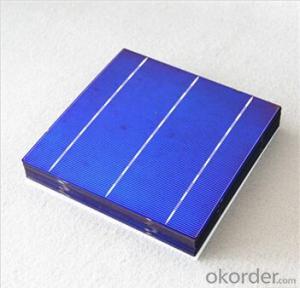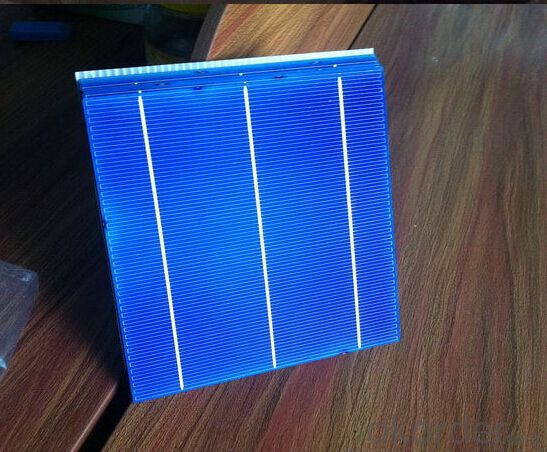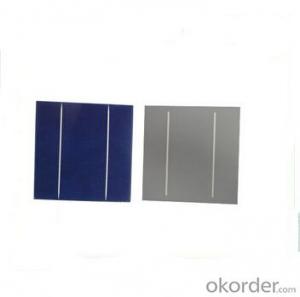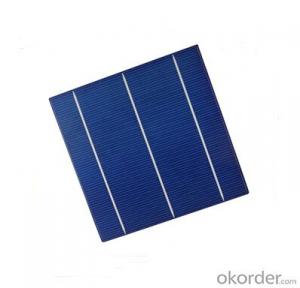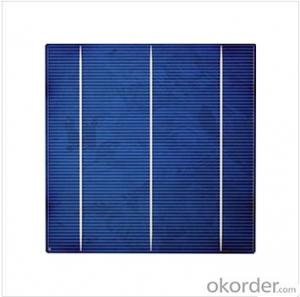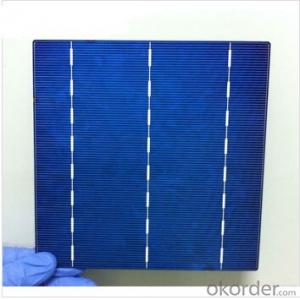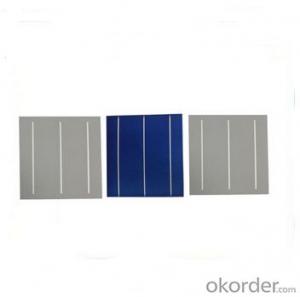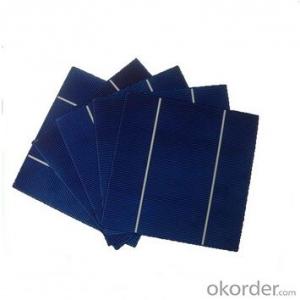Solar Cells Free Polycrystalline Solar Cells Series- 17.00-18.20% 156mmx156mm±0.5mm
- Loading Port:
- Shanghai
- Payment Terms:
- TT OR LC
- Min Order Qty:
- 3000 pc
- Supply Capability:
- 300000 pc/month
OKorder Service Pledge
OKorder Financial Service
You Might Also Like
Solar Cells:
Solar cells is made by solar wafer, it has three categories of solar cell right now, monocrystalline polycrystalline and thin film,These cells are entirely based around the concept PN junction, which is the critical part of solar module, it is the part that can convert the light energy into electricity, the thickness is from 180um to 200um, with even busbars to conduct electricity, textured cell can decrease diffuse reflection; they are often electrically connected and encapsulated as a module. Photovoltaic modules often have a sheet of glass on the front (sun up) side, allowing light to pass while protecting semiconductor wafers from abrasion and impact due to wind-driven debris, rain, hail, etc. Solar cells are also usually connected in series in modules, creating an additive voltage. Connecting cells in parallel will yield a higher current;With high quality and stable quality. Our Cells can greatly improve the performance of Solar Modules.
Features:
1. High conversion efficiencies resulting in superior power output performance.
2. Proven long term mechanical stability of silicon
3. Make of highly purified poly silicon
4. Three bus bars for reduced series resistance and improved module and cell efficiency
5. Blue anti-reflecting coating ensures improved light absorption and increased efficiency
6. Acid texturization offers a uniform appearance and virtually invisible crystal structure
Solar Cells Advantage:
1. Tire-1 Solar Cells’ Manufacturer Quality Guarantee. With a complete and sophisticated quality government system, our Quality Management have arrived world’s leading place. Customer can receive Tire-1 Cells Maker’s Quality Standard Products.
2. Trusted Warranty. We can supply trusted after-sales service to our customer. If our cells are found not in conformity to the specification of manufacturer, or should the inspected quantity found in shortage, or should the packing found damaged, the buyer has the right to claim to the seller. The claim, if any, should be presented to seller within 30 days after cargo's arrival date to the port, together with related inspection report and photos issued and provided by a reputable independent surveyor such as SGS.
3. World’s Leading Manufacturer Equipment. We imported the newest and leading production equipment from abroad. Advanced equipment can guarantee the stable quality of cells. Auto production line can also save labor cost which will further cut our production cost.
Specifications:
Dimension | 156mmx156mm±0.5mm |
Thickness(Si) | 180µm ±20µm, 200µm±20µm |
Front | Blue silicon nitride anti-reflective coatings 1.4mm silver busbar |
Back | Full-surface aluminum back-surface field 2.5mm(silver/aluminum discontinuous soldering pads) |
Efficiency code | 182 | 180 | 178 | 176 | 174 | 172 | 170 | |
Efficiency | Eff(%) | 18.20 | 18.00 | 17.80 | 17.60 | 17.40 | 17.20 | 17.00 |
Power | Ppm(W) | 4.43 | 4.38 | 4.33 | 4.28 | 4.23 | 4.19 | 4.14 |
Max. Power current | Ipm(A) | 8.26 | 8.22 | 8.17 | 8.12 | 8.08 | 8.05 | 7.99 |
Short Circut Current | Isc(A) | 8.71 | 8.68 | 8.63 | 8.60 | 8.56 | 8.53 | 8.49 |
Max. Power Voltage | Vpm(V) | 0.536 | 0.533 | 0.530 | 0.527 | 0.524 | 0.521 | 0.518 |
Open Cirtuit Voltage | Voc(V) | 0.634 | 0.632 | 0.630 | 0.627 | 0.625 | 0.622 | 0.620 |
Efficiency code | 168 | 166 | 164 | 162 | 160 | 158 | 156 | |
Efficency | Eff(%) | 16.80 | 16.60 | 16.40 | 16.20 | 16.00 | 15.80 | 15.60 |
Power | Ppm(W) | 4.09 | 4.04 | 3.99 | 3.94 | 3.89 | 3.85 | 3.79 |
Max. Power Current | Ipm(A) | 7.94 | 7.90 | 7.85 | 7.80 | 7.75 | 7.71 | 7.68 |
Short Circuit Current | Isc(A) | 8.45 | 8.41 | 8.38 | 8.35 | 8.32 | 8.25 | 8.22 |
Max. Power Volgate | Vpm(V) | 0.515 | 0.512 | 0.509 | 0.507 | 0.505 | 0.504 | 0.502 |
Open Circut Voltage | Voc(V) | 0.618 | 0.616 | 0.614 | 0.613 | 0.612 | 0.610 | 0.609 |
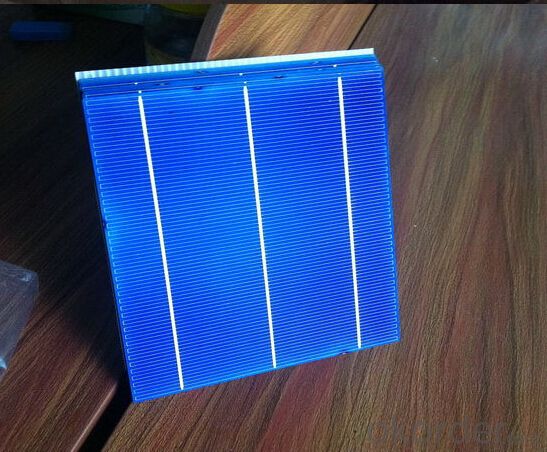
FAQ
We have organized several common questions for our clients,may help you sincerely:
①What price for each watt?
It depends on the efficiency of the solar cell, quantity, delivery date and payment terms.
②How long can we receive the product after purchase?
In the purchase of product within three working days, We will arrange the factory delivery as soon as possible. The pecific time of receiving is related to the state and position of customers.Commonly 7 to 10 working days can be served.
③Can you provide the peripheral products of the solar panels, such as the battery, controller, and inverter? If so, can you tell me how do they match each other?
Yes, we can, we have two companies for solar region, one is CNBM International, the other is CNBM engineering Co.
We can provide you not only the solar module but also the off grid solar system, we can also provide you service with on grid plant.
④What is your warranty of solar cell?
Our product can promise lower than 0.3% open box crack, we support claim after opening the box if it has crackm color difference or sth, the buyer should give pictures immediately, we can not accept the claim after the solar cell has assembled to solar panel.
• Timeliness of delivery
• ⑤How do you pack your products?
We have rich experience on how to pack the solar cell to make sure the safety on shipment, we could use wooden box or pallet as buyer's preference.
- Q: Can solar cells be used in space heating systems?
- Yes, solar cells can be used in space heating systems. Solar thermal systems can collect and convert sunlight into heat energy, which can then be used to heat spaces. Solar panels can also be used to generate electricity, which can power electric space heaters.
- Q: Can solar cells be used for water desalination?
- Yes, solar cells can be used for water desalination. Solar energy can be harnessed to power the desalination process, where the energy from the sun is converted into electricity by solar cells and used to separate the salt and impurities from seawater, making it suitable for drinking or agricultural purposes. This method, known as solar desalination, is an environmentally friendly and sustainable solution for addressing water scarcity in coastal areas.
- Q: What should I know about the Crystalline silicon photovoltaic cells?
- Crystalline silicon photovoltaic cells is the most early development of a solar cell. 1.leV, the band gap width of silicon, is an indirect migration type semiconductor, which is not the most suitable material for making solar cells.
- Q: Can solar cells be used for powering oil rigs?
- Yes, solar cells can be used for powering oil rigs. They can provide a renewable and sustainable source of energy to run various equipment and systems on the rig. Solar panels can be installed on the rig's surface or nearby structures to capture sunlight and convert it into electricity, reducing the reliance on traditional fossil fuel-based power sources.
- Q: What is the role of voltage regulators in solar cell systems?
- The role of voltage regulators in solar cell systems is to ensure a stable and regulated output voltage from the solar panels. They act as a control mechanism to prevent overcharging of batteries or damage to electronic devices by regulating the incoming voltage from the solar cells. Voltage regulators also help optimize the efficiency of the solar cell system by matching the voltage levels of the solar panels with the load requirements, thereby maximizing the energy conversion and utilization.
- Q: What is the payback period for solar cell installations?
- The payback period for solar cell installations varies depending on various factors such as the initial investment cost, location, incentives, and energy consumption. On average, it typically ranges from 5 to 10 years, but in some cases, it can be as short as 3 years or as long as 15 years.
- Q: How are solar cells used in calculators?
- Solar cells are used in calculators to convert sunlight into electrical energy. This energy is then used to power the calculator, eliminating the need for batteries or other external power sources.
- Q: Can solar cells be used in powering autonomous vehicles?
- Yes, solar cells can be used to power autonomous vehicles. Solar panels can be installed on the exterior or integrated into the body of the vehicle to capture sunlight and convert it into electricity. This renewable energy source can help supplement the vehicle's power needs, extending its range and reducing its reliance on fossil fuels. Additionally, advancements in solar technology and efficiency are making it more feasible to use solar power as a primary or secondary energy source for autonomous vehicles.
- Q: How much energy can a solar cell produce?
- The amount of energy a solar cell can produce depends on various factors such as its size, efficiency, sunlight intensity, and duration of exposure. On average, a standard solar cell can generate around 200 to 300 watts of power per square meter under optimal conditions. However, advancements in technology are continuously increasing the efficiency and power output of solar cells.
- Q: Can solar cells generate electricity on cloudy days?
- Yes, solar cells can generate electricity on cloudy days. While their efficiency may be reduced compared to sunny days, solar cells can still convert sunlight, even on cloudy days, into usable electricity.
Send your message to us
Solar Cells Free Polycrystalline Solar Cells Series- 17.00-18.20% 156mmx156mm±0.5mm
- Loading Port:
- Shanghai
- Payment Terms:
- TT OR LC
- Min Order Qty:
- 3000 pc
- Supply Capability:
- 300000 pc/month
OKorder Service Pledge
OKorder Financial Service
Similar products
Hot products
Hot Searches
Related keywords
